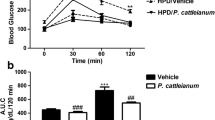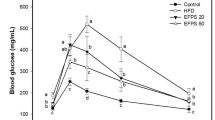Abstract
High-sucrose high-fat diets are one of the causes of malnutrition, and may induce metabolic alterations such as dyslipidemia, insulin resistance, and adipogenesis. The objective of this work was to investigate the possible protective effect of traditionally edible avocado creole peel (Persea americana Mill var. drymifolia) when consuming a high-sucrose and fat diet (HSFD). The experimental animal model included 21 male Wistar rats divided in three groups: the control group received a standard diet of purina®, the HSFD group received a high fat diet plus 30% sucrose in drinking water, and finally the HSFD + AP group received the HSFD diet supplemented with 200 mg/kg of avocado peel for 14 weeks. It was observed that alterations included higher cholesterol, glucose, insulin, fatty acids and TNF-α levels as well as lower HDL, and adiponectin. The addition of avocado peel reverted some of these effects, resulting in normal values of triglicerides, insulin and adiponectin, while attenuated the levels of total cholesterol. Liver weight of the group added with avocado peel was similar to the control group. The neuronal density in the hippocampal areas CA1 and dentate gyrus DC were lower in the high glucose fat group, while the ingestion of the avocado peel showed a neuroprotective effect. The avocado creole ingestion reverted or attenuated most of the metabolic effects caused by a high-sucrose fat diet which was attributed to the compounds detected by HPLC-MS and GC-MS that included bioactive polyphenols such as flavanol quercetin, flavanone naringenin, flavan 3-ol catechin, cyanidin 3-glucoside, pelargonidin 3-glucoside, pelargonidin 3-rhamnoside, hydroxydelphinidin, eugenol and estragole.



Similar content being viewed by others
References
Billingsley H, Carbone S, Lavie C (2018) Dietary fats and chronic noncommunicable diseases. Nutrients 10:1385–1401
Calvo-Ochoa E, Arias G (2014) Celular and metabolic alterations in the hippocampus caused by insulin signalling dysfunction and its association with cognitive impairment during aging and alzheimer´s disease: studies in animal models. Diabetes Metab Res Rev 31:1–13
Bhuyan DJ, Alsherbiny MA, Perera S, Low M, Basu A, Devi OA, Barrooah MS, Li CG, Papoutsis K (2019) The odyssey of bioactive compounds in avocado (Persea americana) and their health benefits. Antiox 8:426
Espinosa-Velázquez R, Dorantes-Alvarez L, Gutiérrez-López GF, García-Armenta E, Sánchez-Segura L, Perea-Flores MJ, Ceballos-Reyes GM, Ortíz-Moreno A (2016) Morpho-structural description of unripe and ripe avocado pericarp (Persea americana Mill var. drymifolia) description. Rev Mex Ing Quim 15(2):469–480. https://rmiq.org/ojs311/index.php/rmiq/article/view/1144
Corrales-García JE, García-Mateos MR, Martínez-Lopéz E, Barrientos-Priego AF, Ybarra-Moncada MC, Ibarra-Estrada E, Méndez-Zúñiga SM, Becerra-Morales D (2019) Anthocyanin and oil contents, fatty acids profiles and antioxidant activity of Mexican landrace avocado fruits. Plant Foods Hum Nutr 74:210–215. https://doi.org/10.1007/s11130-019-00721-1
Yoo KM, Lee CH, Lee H, Moon B, Lee CY (2008) Relative antioxidant and cytoprotective activities of common herbs. Food Chem 106:929–936
National Research Council (US) (2011) Guide for the care and use of laboratory animals. National Academies Press, Washington, DC, pp 11–40
Guzmán-Gerónimo RI, Alarcón-Zavaleta TM, Oliart-Ros RM, Meza-Alvarado JE, Herrera-Meza S, Chávez-Servia JL (2016) Blue maize extract improves blood pressure, lipid profiles, and adipose tissue in high-sucrose diet-induced metabolic syndrome in rats. J Med Food 20:110–115
Kusindarta DL, Wihadmadyatami H, Haryanto A (2018) The analysis of hippocampus neuronal density (CA1 and CA3) after Ocimum sanctum ethanolic extract treatment on the young adulthood and middle age rat model. Vet World 11(2):135–140
Paxinos G, Watson C (2007) The rat brain in stereotaxic coordinates, 6th edn. Elsevier Ltd., London
Cory H, Passarello S, Szeto J, Tamez M, Mattei J (2018) The role of polyphenols in human health and food systems: a mini-review. Front Nutr 5:87. https://doi.org/10.3389/fnut.2018.00087
Drewnowski A, Almiron-Roig E (2010) Human perceptions and preferences for fat-rich foods. In: Montmayeur JP, le Coutre J (eds) Fat detection: taste, texture, and post ingestive effects, 1st edn. CRC Press/Taylor & Francis, Boca Raton, FL, pp 243–268
Cao L, Liu X, Cao H, Lv Q, Tong N (2012) Modified high-sucrose diet-induced abdominally obese and normal-weight rats developed high plasma free fatty acid and insulin resistance. Oxid Med Cel Longev 2012:374346
Chaiittianan R, Sutthannut K, Rattanathongkom A (2017) Purple corn silk: a potential anti-obesity agent with inhibition on adipogenesis and induction on lipolysis and apoptosis in adipocytes. J Ethnopharmacol 201:9–16
Pu P, Gao D, Mohamed S, Chen J, Zhang J, Zhou X, Zhou N, Xie J, Jiang H (2012) Naringin ameliorates metabolic syndrome by activating AMP-activated protein kinase in mice fed a high- fat diet. Arch Biochem Biophys 518:61–70
Luna-Vital D, Luzardo-Ocampo I, Cuellar-Nuñez L, Loarca-Pina G, Gonzalez de Mejia E (2019) Maize extract rich in ferulic acid and anthocyanins prevents high-fat induced obesity in mice by modulationg SIRT1, AMPK, and IL-6 associated metabolic and inflammatory pathways. J Nutr Biochem 79:108343. https://doi.org/10.1016/j.jnutbio.2020.108343
Tsuda T, Ueno Y, Kojo H, Yoshikawa T, Osawa T (2005) Gene expression profile of isolated rat adipocytes treated with anthocyanins. Biochim Biophys Acta 1733:137–147
Huang K, Liang X, Zhong Y, He W, Wang Z (2014) 5-Caffeoylquinic acid decreases diet-induced obesity in rats bymodulating PPARα and LXRα transcription. J Sci Food Agric 95:1903–1910
Bloemer J, Pinky P, Govindarajulu M, Hong H, Judd R, Amin R, Moore T, Dhanasekaran M, Reed M, Suppiramaniam V (2018) Role of adiponectin in central nervous system disorders. Neural Plast 2018:4593530. https://doi.org/10.1155/2018/4593530
Wu T, Tang Q, Gao Z, Yu Z, Song H, Zheng X, Chen W (2013) Blueberry and mulberry juice prevent obesity development in C57BL/6 mice. PLoS One 8:10
Bracke A, Domanska G, Bracke K, Harzsch S, Brandt JV, Bröker B, Halbach O (2019) Obesity impairs and adult hippocampal neurogenesis. J Exp Neurosci 13:1–10
Valladolid-Acebes I, Merino B, Principato A, Fole A, Barbas C, Lorenzo MP, Gracía A, Del Olmo N, Ruiz-Gayo M, Cano V (2012) High- fat diets induce changes in hippocampal glutamate metabolism and neurotransmission. Am J Physiol Endocrinol Metab 302:396–402
Basil A, Soulet S, Chaher N, Mérillon JM, Chibane M, Monti JP, Richard T (2012) Wine polyphenols: potential agents in neuroprotection. Oxid Med Cell Longev 2012:805762. https://doi.org/10.1155/2012/805762
Gómez-Serranillos MP, Martín S, Ortega T, Palomina OM, Palomina OM, Prodanov M, Vacas V, Hernández T, Estrella I, Carretero ME (2009) Study of red wine neuroprotection on astrocytes. Plant Foods Hum Nutr 64:238–243
Tsuda T (2012) Dietary anthocyanin-rich plants: biochemical basis and recent progress in health benefits studies. Mol Nutr Food Res 56:159–170
Pereira GD, Cavegn N, Nix A, Do Nascimento MC, Stangl D, Anwar MS, Nardi AE, Franca PG, Thuret S (2012) The role of dietary polyphenols on adult hippocampal neurogenesis: molecular mechanisms and behavioural effects on depression and anxiety. Oxid Med Cell Longev 2012:541971. https://doi.org/10.1155/2012/541971
Acknowledgements
This work was supported by the Instituto Politécnico Nacional (Mexico) projects SIP 20201014 and 20195428.
Author information
Authors and Affiliations
Corresponding author
Ethics declarations
Conflict of Interest
The authors declare that there is no conflict of interest in the study.
Electronic Supplementary Material
ESM 1
(DOCX 23 kb)
Rights and permissions
About this article
Cite this article
Miñón-Hernández, D., Dorantes-Alvarez, L., Guzmán-Gerónimo, R.I. et al. Avocado Creole Peel Ameliorates Metabolic Alterations Caused by a High Sucrose Fat Diet in a Wistar Rats Model. Plant Foods Hum Nutr 76, 12–19 (2021). https://doi.org/10.1007/s11130-020-00867-3
Received:
Revised:
Accepted:
Published:
Issue Date:
DOI: https://doi.org/10.1007/s11130-020-00867-3




